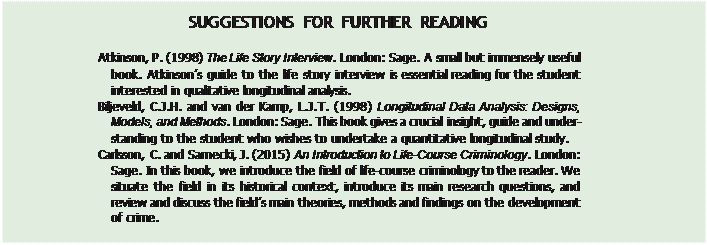 |
Summary and review
|
|
|
|
Time
Finally, the dimension of time is what distinguishes longitudinal and life-course stud- ies from other branches of research. Above, we mentioned that our measure of time can be retrospective or prospective, and that the number of ‘waves’ can range from one alone (and, thus, fully retrospective) to five, 10, 15 or more follow-ups. Here, we must decide how many follow-up waves we should carry out, and when we should do so. Ideally, of course, this should be decided based on the project’s research questions. If we are only interested in understanding continuity and change in crime during the pathway from adolescence to young adulthood, for example, it seems pointless to conduct a follow-up study beyond age 30. Instead, we should direct all our resources to get as close and detailed a study as we can of the years between, say, 15 and 25. As always, however, and just as in the case with the other dimensions of the research project, we are likely to have to make a compromise between our ambitions and theoretical ideals, and our economic and other, practical conditions and requirements.
When studying criminal careers, observing teenagers and young adults every year
or every second year may be particularly useful, since criminal activity is relatively
common during these years. If we want to study, say, their self-reported criminal offending, as often as once a year would be ideal. Using longer time frames between observations when it comes to self-reported offending is possible but not desirable, due to the problems of memory recollection. The same goes for studying other facets of the criminal career, which often demand many observation periods, with short time lapses in between. One such issue concerns the onset of crime, another desist- ance, and intermittency, where the individual temporarily ceases offending before recidivating.
In our own research project, the SLCP, the number of observation periods was relatively few: three or four, depending on which sample we were referring to. The use of register data offered no problems here, but interviewing them did: at every observation period, we had to rely on the interview participants’ retrospective accounts of longer periods of their lives, during which we had had no contact with them. The problem with this, of course, is that much of what interview participants say about their past may be affected by what has happened later in life. The past is, in a sense, always seen and narrated from the perspective of the present. In our inter- views (which were conducted on a smaller, strategically chosen subset of the sample), we asked the interview participants to talk about their whole life course. This made it possible for us to compare their life histories as told at age 35 or 40, with the life histories collected from them when they were in their 60s. We also had the possibil- ity of comparing their interviews to the more reliable register data (reliable in the sense that registers do not forget or mix up the timing of events).
|
|
|
One obvious advantage of not having too many observation periods where the
sample is actively involved in the data collection (such as interviews or various forms of tests), is that they do not get tired of being examined and leave the study, which increases the attrition rate. Additionally, and importantly, the various obser- vation periods can be assumed to be relatively independent of each other: it is unlikely that the interview participant or respondent remembers what s/he has said during the previous observation period, and, thus, feels no need to stick to a given life history or anything along those lines. However, in studies where the observation periods are many and occur frequently, studies have shown that there tends to develop a relationship between the researcher and the interview partici- pant, which, in turn, may decrease the number of incidences of attrition and missing data.
SUMMARY AND REVIEW
In this chapter, we have outlined the nature, developments, strands, advantages and disadvantages of longitudinal research, and a life-course perspective on criminological topics. At one level, life-course studies are concerned with the ‘age- graded sequence of roles, opportunities, constraints and events that shape the
biography from birth to death’ (Shanahan and MacMillan, 2008: 40). Recently, however, life-course studies have in a way moved beyond this final stage of the life course, by asking partly new research questions. For example, we know that ‘crime runs in families’ – one of the oldest findings in criminology. But what is the extent of this intergenerational transmission, and do children follow similar offending trajectories as their parents? If so, to what extent? These questions are only just now beginning to be investigated (e. g. Besemer and Farrington, 2012; Besemer et al., 2016) and, once again, this puts the spotlight on core crimino- logical questions about the causes of crime: are they predominantly social, genetic, epi-genetic – or a combination of these? Only time, and continued criminological research, will tell.
Life-course criminology is a research enterprise where longitudinal methodology is utilized in various ways: some use only quantitative data and try to uncover con- tinuity and change in criminal careers by studying official records, specifically made tests, assessments and/or self-report surveys. Others use qualitative life history inter- views to explore the complexity and processual nature of human life. Some studies combine both quantitative and qualitative methods.
Every method has its strengths, but also its weaknesses. The basic question any potential life-course researcher should start with is: what do I want to know? Beginning with the research question is the scientific ideal and it gets you a long way. The next issue to pursue is whether a method or set of data already exists – or is possible to collect – to answer that question for you. If not, you need to rethink the research question somewhat.
If already at the outset you are faced with a given set of data, whether quantitative and qualitative, a good starting point is to explore the data: what are the character- istics of the sample? What information does it include? Has the information been collected prospectively or retrospectively? Answering these questions simultaneously provides you with the limits and possibilities inherent in the data.
|
|
|
Being pragmatic is not always desirable, but in social research, and life-course and longitudinal research in particular, it is often the only possible way forward.
 | |||
 | |||



 Blumstein, A., Cohen, J., Roth, J. A. and Visher, C. A. (eds) (1986) Criminal Careers and Career Criminals. Washington, DC: National Academy Press.
Blumstein, A., Cohen, J., Roth, J. A. and Visher, C. A. (eds) (1986) Criminal Careers and Career Criminals. Washington, DC: National Academy Press.
Bushway, S. D., Piquero, A. R., Broiday, L. M., Cauffman, E. and Mazzerolle, P. (2001) ‘An empirical framework for studying desistance as a process’, Criminology, 39: 491–515. Carlsson, C. (2014) ‘Continuities and Changes in Criminal Careers’, Dissertation, Stockholm
University, Department of Criminology.
Carlsson, C. and Sarnecki, J. (2015) An Introduction to Life-Course Criminology. London: Sage.
Cusson, M. and Pinsonneault, P. (1986) ‘The decision to give up crime’, in D. Cornish and
R. V. Clarke (eds), The Reasoning Criminal: Rational Choice Perspectives on Offending. New York: Springer-Verlag.
de Lange, A. (2005) What about Causality? Examining Longitudinal Relations between Work Characteristics and Mental health’, Dissertation, University of Amsterdam.
Farrington, D. P., Piquero, A. R. and Jennings, W. G. (2013) Offending from Childhood to Late Middle Age: Recent Results from the Cambridge Study in Delinquent Development. New York: Springer.
Giordano, P. C., Cernkovich, S. A. and Rudolph, J. L. (2002) ‘Gender, crime, and desistance: toward a theory of cognitive transformation’, American Journal of Sociology, 107: 990–1064.
Glueck, S. and Glueck, E. (1950) Unraveling Juvenile Delinquency. New York: Commonwealth Fund.
Laub, J. H. and Sampson, R. J. (2003) Shared Beginnings, Divergent Lives: Delinquent Boys to Age 70. Cambridge, MA: Harvard University Press.
Loeber, R., Farrington, D. P., Stouthamer-Loeber, M., Moffitt, T. E. and Caspi, A. (1998) ‘The development of male offending: key findings from the first decade of The Pittsburgh Youth Study’, Studies on Crime and Crime Prevention, 7: 141–71.
Maruna, S. (2001) Making Good: How Ex-Convicts Reform and Rebuild their Lives. Washington, DC: American Psychological Association.
Maruna, S. (2010) ‘Mixed method research in criminology: why not go both ways? ’ In
A. R. Piquero and D. Weisburd (eds), Handbook of Quantitative Criminology. New York: Springer.
Meisenhelder, T. (1977) ‘An exploratory study of exiting from criminal careers’, Criminology, 15: 319–34.
Piquero, A. R., Farrington, D. P. and Blumstein, A. (2007) Key Issues in Criminal Career Research. Cambridge: Cambridge University Press.
Sampson, R. J. (2013) ‘The place of context: a theory and strategy for criminology’s hard problems’, Criminology, 51: 1–31.
Sampson, R. J. and Laub, J. H. (1993) Crime in the Making: Pathways and Turning Points through Life. Cambridge, MA: Harvard University Press.
Sarnecki, J. (1985) Predicting Social Maladjustment: Stockholm Boys Grown Up
I. Stockholm: Esselte Tryck.
Shanahan, M. J. and MacMillan, R. (2008) Biography and the Sociological Imagination. New York: Norton.
 |

|
|
|


